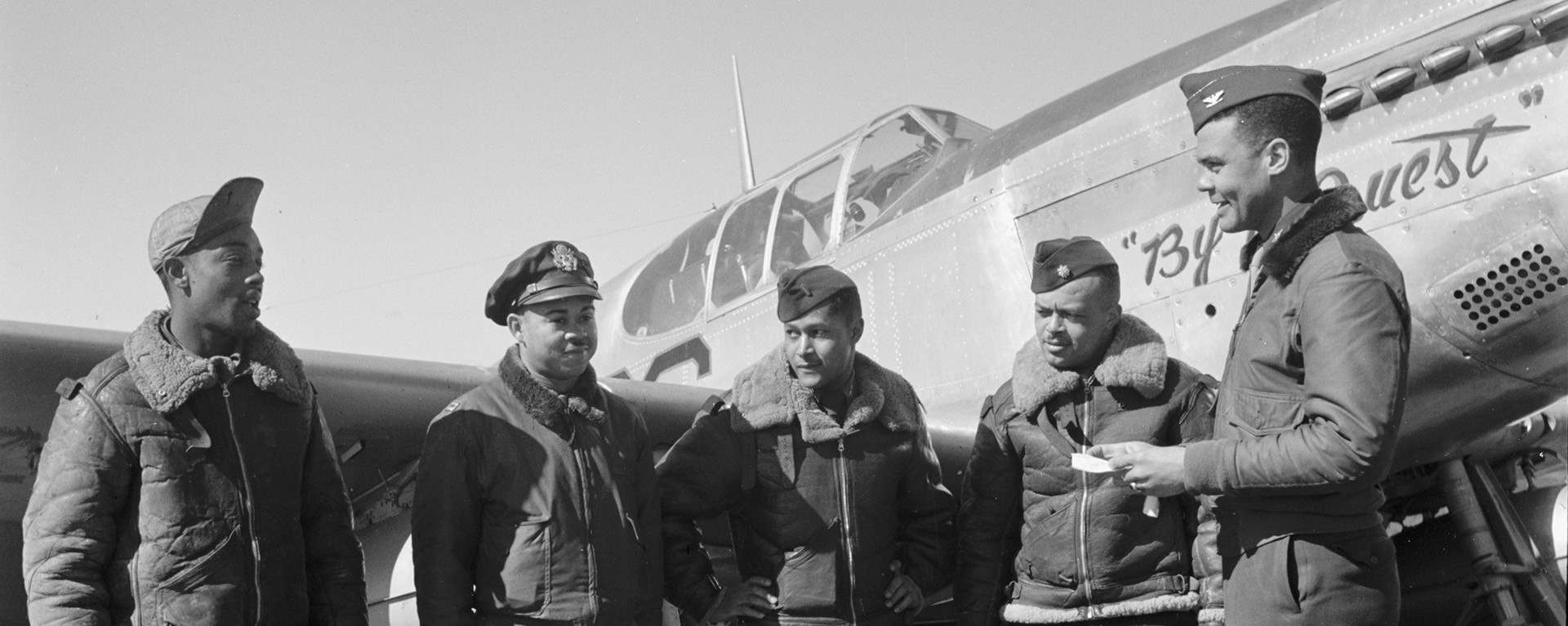Profiling Heroes: Tuskegee Airmen Fighter Pilots
Explore the Lives of Some of the First African-American Pilots to Experience Combat
Nearly 1,000 pilots and some 14,000 personnel served as Tuskegee Airmen between 1941 and 1949. These brief profiles explore the lives of only a select few. There are many more Tuskegee Airmen stories to learn!
Benjamin O. Davis, Jr. (1912-2002)
When Benjamin O. Davis, Jr. graduated from West Point in 1936, he and his father, Benjamin O. Davis, Sr. (1880-1970), were the only Black officers in the U.S. military. Together they’d open the door for thousands more to follow in their footsteps.
At West Point, white cadets refused to speak to the younger Davis outside of formal training. It only strengthened his determination, and he graduated 35th in a class of 276. Davis wanted to fly, but the Army said no.
When a Black flying group was finally created in 1941, Davis was among its first class of graduating pilots. He would lead three major units of the famed Tuskegee Airmen, including the first group to enter combat, the 99th Fighter Squadron. When a number of white officers appealed to remove the Black pilots from action citing low performance, Davis went to Washington, D.C. to challenge the claim. When the Army investigated, the Tuskegee Airmen’s successful record spoke for itself.
Davis’ commitment to excellence ensured the Airmen’s success at protecting Allied bomber planes, and Davis named his fighter “By Request” in reference to their growing reputation. Because of his insistence that his pilots stay with the bombers rather than chase enemy planes and leave them exposed, the Tuskegee Airmen outperformed many of their white counterparts on escort missions.
When Davis received the Distinguished Flying Cross for his combat service over Europe and Africa, his father pinned the medal to his son’s uniform. The son of America’s first Black general in the Army would become the first Black general in the new Air Force. Retiring from service in 1970, General Davis received his fourth star from President Bill Clinton in 1998.
Lee Archer (1919-2010)
As both the grandson and son of veterans, Lee Archer understood the importance of service. As a young man, he aspired to fight in the air as a pilot, and attempted to join the Army Air Corps before formal Tuskegee Airmen units had been formed. Although he passed the test, he was rejected because of his race, and Archer entered the regular Army.
Once a new segregated flying unit was established, Archer was able to transfer to Tuskegee, Alabama for training, where he finished top of his class. He went overseas to Italy with the 332nd Fighter Group, and flew P-39s on harbor patrols and P-47s on bomber escort missions. His first aerial victory came in July, 1944.
Eventually, Archer was able to fly the coveted P-51 Mustang, and during a mission over Hungary, he shot down three German aircraft in succession. Archer had become one of the Tuskegee Airmen’s best fighter pilots, and one of the few to achieve four total victories.
Coming home, Archer took advantage of military opportunities to further his education, and as a civilian became one of the first African-American vice presidents of a major corporation. He remained a firm proponent of education in its many forms.
Roscoe C. Brown, Jr. (1922-2016)
Having attended segregated schools as a child, Roscoe C. Brown, Jr. finished at the top of his class at Springfield College in 1943, and volunteered as one of the first Black pilots in the United States military. He excelled in combat and was one of the first Americans to shoot down the new German fighter jet in World War II. He flew 68 missions over Europe and was awarded the Distinguished Flying Cross.
Returning home, Brown earned a Ph.D. in exercise physiology from New York University, and became a pillar of his community, holding such prestigious jobs as president of Bronx Community College and director of the Center for Urban Education Policy at City University of New York. He was instrumental in local and national civil rights groups, charities, and foundations. A marathon runner and father of four, Brown won an Emmy in 1973 for his work on the TV series Black Arts.
In 2007, Brown and his fellow Tuskegee Airmen collectively received the Congressional Medal of Honor, and two years later were invited as honored guests of President Barack Obama at his inauguration. When Captain Brown died in 2016, American fighter jets offered a rare tribute by flying over his memorial ceremony in New York City.
Charles E. McGee (b. 1919)
Charles E. McGee is a Cleveland, Ohio native and studied engineering at the University of Illinois before World War II. Fascinated with aviation, McGee soon became a Tuskegee Airmen, and joined the 332nd Fighter Group. He deployed to Europe in 1944 and ultimately became a flight leader.
McGee scored his first aerial victory while escorting B-17 bombers, and eventually flew 137 missions during the war, among the highest for any Tuskegee Airman. Returning home to America, he became a flight instructor for multi-engine aircraft. Many returning veterans like McGee found themselves back in a country still plagued by segregation and racism.
After the integration of the Armed Forces in 1948, McGee remained in the service until his retirement in 1973. His honors include 409 combat missions between World War II, Korea, and Vietnam. This astounding number included more than 100 missions in each conflict and remains among the best records for Air Force fighter pilots during the three wars. It is also the best among Tuskegee Airmen.
Having retired as a colonel, the 100-year-old Charles McGee became a brigadier general in early 2020.
Learn More About the Tuskegee Airmen in the documentary Double Victory. Watch for free:
Lucas O. Seastrom is a writer and historian at Lucasfilm.

